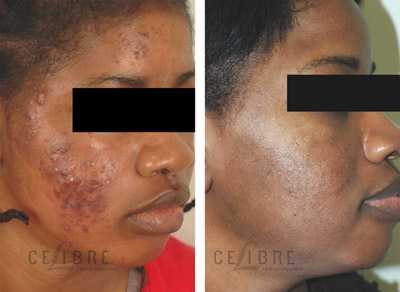If you’ve struggled with acne, you know that the breakouts themselves are frustrating—but the scars they leave behind can be even harder to deal with. The good news is that modern dermatology offers several effective options for improving or even removing acne scars. The best treatment for you depends on the type of scars you have, their severity, your skin type, and how much downtime you can manage. Most people need a series of laser treatments or combination therapies to see smooth, even skin again.
In this guide, we’ll explain how to remove scars from acne, what treatments work best, how many sessions you might need, and what factors affect your results.
About Acne Scars
Acne scars form when inflamed pimples damage the skin’s tissue. As your skin tries to heal, it can produce too much or too little collagen, leading to uneven texture. Some scars look like tiny pits or depressions (known as atrophic scars), while others appear raised or discolored. The most common types of acne scars include:

- Ice pick scars: Deep, narrow holes in the skin.
- Boxcar scars: Wider depressions with defined edges.
- Rolling scars: Wavelike indentations that make the skin look uneven.
- Post-inflammatory hyperpigmentation (PIH): Dark spots left after acne heals.
Understanding what kind of scars you have helps your dermatologist choose the most effective treatment plan.
Laser Treatments for Acne Scars
Laser therapy is one of the most effective methods to remove or reduce acne scars. It works by stimulating new collagen production and resurfacing the damaged layers of skin. But how many acne laser treatments are required depends on several factors—your skin type, scar depth, and tolerance for downtime.
Here’s what to expect:
- Mild acne scarring: 3–5 sessions spaced about 4 weeks apart.
- Moderate to severe scarring: 6–9 sessions spaced 2–4 weeks apart.
- Combination acne and pigmentation issues: Often require additional treatments using different laser types or complementary therapies.
A patient with mild inflammatory acne and minimal scarring might see results after a few treatments. In contrast, someone with deep cystic acne scars, discoloration, and texture irregularities may need a longer, more customized plan.
Types of Laser Treatments for Acne Scars
Not all lasers are the same. Your dermatologist will choose one based on your skin tone, scar type, and goals. The main laser options include:
Fractional CO2 Laser: This is often considered the gold standard for deep acne scars. It removes damaged skin layers and boosts collagen production for smoother texture. Downtime can range from a few days to a week.
Erbium Laser: A gentler option than CO2, ideal for mild to moderate scars or patients who prefer less recovery time.
Fractional Non-Ablative Laser (like Fraxel): Targets deeper layers without damaging the skin’s surface. Great for people who want gradual results and minimal downtime.
Pulsed Dye Laser (PDL) or Nd:YAG: Often used to treat redness or discoloration left behind by acne.
Other Treatments That Help Remove Acne Scars
While lasers are powerful, they’re not the only option. Many patients benefit from combining laser treatments with other therapies, such as:
- Microneedling: Uses tiny needles to trigger collagen production and smooth out scars.
- Chemical Peels: Help fade discoloration and improve overall texture.
- Dermal Fillers: Temporarily lift depressed scars, especially rolling or boxcar types.
- Subcision: A minor procedure that releases scar tissue pulling the skin down.
- Topical Retinoids and Brightening Creams: Support cell turnover and reduce pigmentation.
Your dermatologist may combine two or more of these treatments for faster, more visible results.
How to Choose the Right Acne Scar Treatment
There isn’t one “best” way to remove acne scars. The right treatment depends on:
- Your skin type and tone (some lasers are better suited for darker skin).
- The type and severity of your scars.
- Your comfort with downtime and recovery.
- Your budget and goals.
A good acne specialist will create a personalized treatment plan based on these factors. They’ll explain what results you can realistically expect and how many sessions you’ll need.
For example, a patient with mostly red or brown marks might see dramatic improvement from non-ablative laser treatments or chemical peels. But someone with deep, textured scarring might need several fractional CO2 laser sessions spaced weeks apart.
Setting Realistic Expectations
Patience is key when treating acne scars. Even with advanced lasers, results take time. Collagen remodeling continues for months after each session, so improvements become more noticeable gradually. Most patients see about 50–80% improvement in texture and tone after completing their full treatment plan.
It’s also important to maintain your results with good skincare habits—daily sunscreen, gentle exfoliation, and non-comedogenic products help prevent new breakouts and protect your investment.
Final Thoughts
Learning how to remove scars from acne starts with understanding that no single treatment works for everyone. The most successful results come from a customized approach that considers your skin, your lifestyle, and your goals.
A skilled dermatologist can help you choose the right combination of laser treatments, microneedling, or chemical peels to restore smoother, more even skin. With the right plan and patience, you can fade acne scars and feel confident in your skin again.

